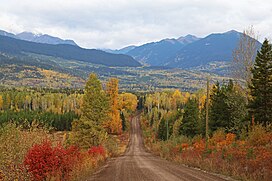| Northern transitional alpine forests | |
|---|---|
 Transitional alpine forest just south of
Witset | |
 | |
| Ecology | |
| Realm | Nearctic |
| Biome | temperate coniferous forests |
| Borders | |
| Bird species | 144 [1] |
| Mammal species | 51 [1] |
| Geography | |
| Area | 25,641 km2 (9,900 sq mi) |
| Country | Canada |
| Provinces | British Columbia |
| Conservation | |
| Conservation status | Vulnerable |
| Habitat loss | 0% [1] |
| Protected | 1.57% [1] |
Northern transitional alpine forests is a temperate coniferous forest ecoregion in the northwestern interior of British Columbia, as defined by the World Wildlife Fund (WWF) categorization system.
Setting
This ecoregion occupies a transitional region of mountains and valleys between the Coast Ranges to the west and the Omineca Mountains to the east. It varies greatly in elevation from the heavily glacierized areas of the Hazelton and Skeena mountains between 2,500–2,800 m (8,200–9,200 ft), to the Nass and Skeena river valleys below 750 m (2,460 ft).
Climate
This ecoregion varies greatly depending on its proximity to the Pacific coast. In the west it has a warm humid continental climate ( Köppen Dsb ) with warm summers and cold winters. In the east it has a subarctic climate ( Köppen Dfc ) with cool summers and cold winters. Precipitation ranges from 2500mm (98.4 in) in the western coastal areas of the Nass River valley, to 600mm (23.6 in) in the lower elevations of the interior Bulkley Ranges. Temperature varies greatly with elevation, but averages around 13°C (55.4°F) in the summer and -9.5°C (14.9°F) in the winter.
Ecology
Flora
The lower mountains and valleys are dominated by western red cedar, western hemlock, and mountain hemlock. Higher elevations are dominated by lodgepole pine, engelmann spruce, and alpine fir, though to a lesser extent in the west of the ecoregion. Vegetation in the alpine tundra includes discontinuous patches of low-growing heather, sedge, and mountain avens.
Fauna
Fauna found throughout this ecoregion include grizzly bear, American black bear, moose, mountain goat, red fox, and wolves. Parts are also populated by woodland caribou, black-tailed deer, beaver, wolverine, marten, snowshoe hare, ptarmigan, and grouse.
See also
References
- ^ a b c d "The Atlas of Global Conservation". maps.tnc.org. Archived from the original on 2012-03-05. Retrieved 2020-08-23.
External links
- "Northern transitional alpine forests". Terrestrial Ecoregions. World Wildlife Fund.